Is God present in our obstacles? Do hindrances lead us to liberation, growth and insight? Now in the middle of the Omer, the countdown–or count up–to our Shavuot celebration of revelation, turn back to the Torah reading from the conclusion of Pesach. In the Song of the Sea, the text tells the story of Egyptians chasing and then the Israelites rescue at the sea. In this celebration of miracle in Hebrew verse, God’s miracles are described step by step: God hurled horse and driver into the sea; God is our strength and might; at the blast of G’s nostrils, the waters piled up like a straight wall.
The list is about to be followed by Michamocha–the declaration of God’s wonders, but first a sentence, seemingly out of order–the text brings back a focus on the Egyptians: “The foe said, ‘I will pursue, I will overtake, I will divide the spoil, My desire shall have its fill of them. I will bare my sword. My hand shall subdue them.”
Our sages are bothered by this insertion—the foes’ pursuit of the Israelites should be mentioned early in the story where they belong in the plot, not while we are thanking God for the miracle of redemption.
Why, in our moment to acknowledge God, do we bring up the foe—the obstacle? Rabbi Nachman of Brazlav teaches: One who is aware looks at a hindrance and finds there, the Creator. One who is not aware, when one sees a hindrance, immediately moves away from it.*
Rabbi Shelia Weinberg, a Jewish meditation teacher, teaches that: When we cultivate such awareness, such mindfulness that we discover God’s presence in our hindrances, in the obstacles on our spiritual path, we are led to liberation, insight and spiritual growth.
As the Israelites approach the Sea of Reeds, they cannot distance themselves from the Egyptians. Just the opposite: they need to encounter their reminder of narrowness, face their obstacle. When the foe is closest, that’s when the act of liberation takes place.
Such a departure from the dualistic thinking of good-evil, black-white, is the challenging thought of Jewish mysticism and Hasidism. Reb Nachman invites us to consider our own spiritual path: What is the obstacle, to which you must draw near, in order to move forward? What is the hindrance from which you have been running? What is the foe you have tried to bury?
It’s the grievance that keeps you stuck in tension with your neighbor. It’s the decades-old rejection from your first-choice college. It’s the disappointment in your family member who never appreciates your efforts. It’s the discomfort in the inequity you face on the Philadelphia street as you leave the door of your home or synagogue. It’s the anger that builds from each work day and from which you find no peace when your head hits the pillow.
What is the narrowness, the Egypt, the hindrance, on our spiritual path? The answer is different for each of us, but a shared path of mindfulness may offer us insight.
For those of us who would like to explore Jewish Meditation as a path toward mindfulness, we will offer a new opportunity from the middle of April to the middle of May. Part of our Rodeph Shalom journey from the Redemption of Pesach to the Revelation of the festival of Shavuot will be a series of four Friday evening Meditation sessions, right before the Shabbat service. Beginning April 19, we will meet in the chapel at 5:00pm for a short teaching and discussion related to Jewish meditation, followed by the opportunity to sit in silence together for about 10 minutes.
Whatever your hindrance, whatever your Egypt, may you face it in a new way, that you might taste something of God’s redemption, and that you might be prepared to say “Mi chamocha–Who is like you Adonai?!”
*Cited in “Approaching the Thick Cloud: Working with Obstacles in Our Spiritual Growth,” Sheila Peltz Weinberg in Jewish Mysticism and the Spiritual Life, ed Lawrence Fine, Eitan Fishbane and Or N. Rose.
